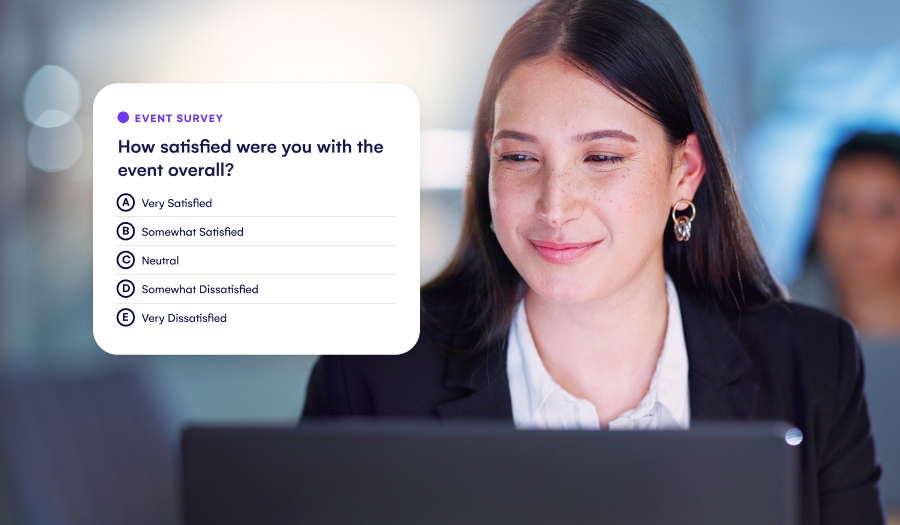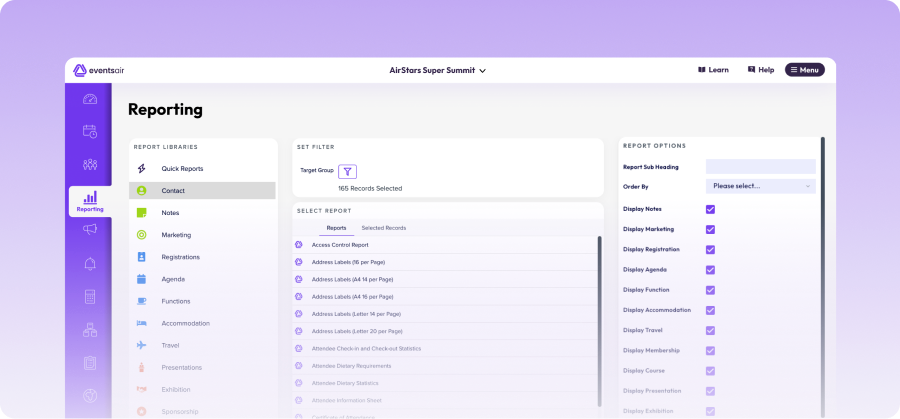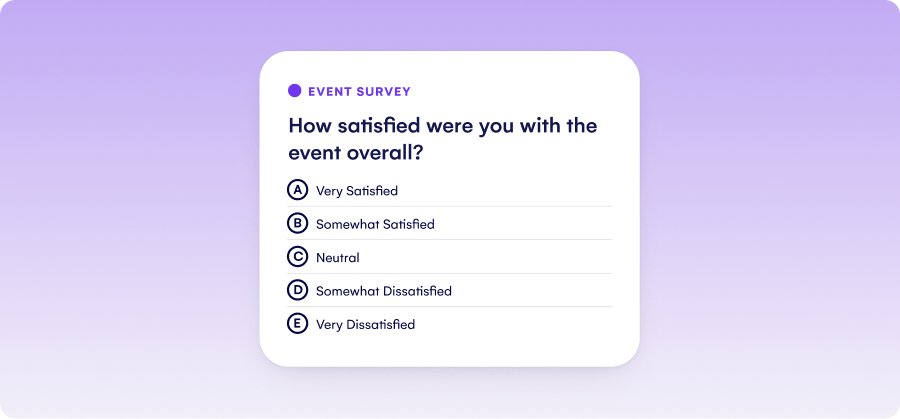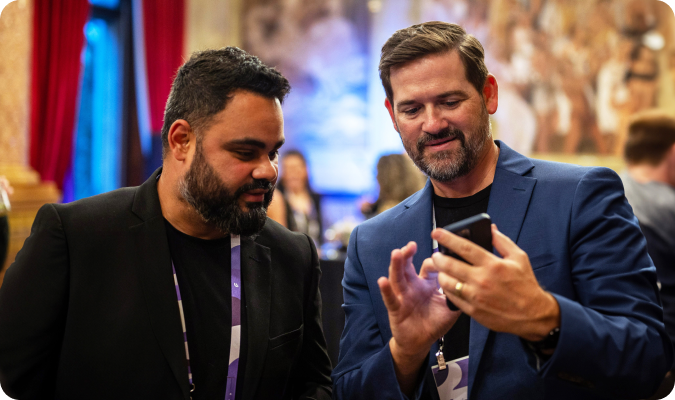
The closing keynote might be over, but the real work of your event isn’t finished yet. In many ways, what happens in the days and weeks after an event can have just as much impact as the big moments on stage.
Post-event follow-up is your opportunity to transform handshakes into lasting partnerships, keep your brand fresh in attendees’ minds, and collect the insights that will shape your next success.
Whether you’ve just wrapped a 5,000-person conference or a half-day hybrid seminar, a well-planned follow-up ensures you don’t lose momentum.
And it’s not just about sending a quick “thanks for coming”, it’s about creating meaningful touchpoints, proving ROI, and setting the stage for even better outcomes next time.
In this EventsAir guide, we’ll share practical, data-driven strategies to help you follow up with impact, covering everything from quick wins to automated workflows, so you can nurture relationships, showcase results, and keep your event buzz alive long after the last attendee leaves.
What is a post-event follow-up?
A post-event follow-up is the strategic process of reconnecting with attendees, sponsors, and partners after your event concludes. It helps you build on event momentum, nurture relationships, and measure success.
When you execute it appropriately, it can improve retention, generate more leads, and boost attendee satisfaction for future events. Ultimately, follow-up is how you turn a single interaction into lasting impact.
Common post-event follow-up tactics include:
- Thank-you emails or videos
- Feedback surveys
- Highlight reels or recap content
- Personalized outreach to high-value leads
For organizers using EventsAir, follow-ups become easier with built-in tools for automated emails, post-event surveys, post-event analytics, and personalized content delivery, all on the same platform that powered your event.

How to successfully follow up after your event
1. Send a thank-you email within 24–48 hours
Your first follow-up should be a personalized “thank-you” message sent within 24 to 48 hours after the event. This simple gesture strengthens relationships, reinforces your brand, and sets the tone for continued engagement.
It’s best to avoid generic messaging, segment your audience, and tailor your message to fit each group:
- Attendees: Thank them for joining, highlight standout moments, and tease upcoming content.
- Speakers: Acknowledge their contribution, share event feedback, and open the door to future opportunities.
- Sponsors: Provide early performance metrics, share social media coverage, and outline next steps.
- VIP Guests: Reference specific conversations or sessions they attended to add a personal touch.
Every thank-you email should include:
- A clear, sincere message of appreciation
- A short recap of the event’s success
- A prompt for next steps (survey, upcoming event registration, etc.)
- A contact for any questions or feedback
This is also your chance to reinforce your brand’s tone and leave a positive final impression.
With EventsAir, you can schedule, personalize, and automate thank-you emails directly from your event dashboard. Use attendee data to segment messaging and monitor engagement.
Timely gratitude goes a long way in turning first-time attendees into long-term advocates.
2. Share on-demand content and key takeaways
Once the event ends, attendees want to revisit what they learnt or catch up with what they missed. Sharing on-demand content and key insights helps extend the value of your event and keeps your audience engaged long after the last session.
Here’s what you can share:
- Session recordings: Make popular sessions available on-demand for replay.
- Presentation slides: Share decks or downloadable resources from speakers.
- Event highlights: Create short videos or infographics that showcase key moments.
- Exclusive takeaways: Summarize major insights, stats, or announcements from the event.
Distribute this content via:
- Post-event email campaigns
- A dedicated content hub or event microsite
- Social media snippets (tag speakers and sponsors for extra reach)
EventsAir can record all your sessions and make them available post-event; with this, you can host all your on-demand content in one place, integrated with your registration data and attendee profiles.

This step not only increases content ROI but also extends the life of your event. Great content keeps attendees engaged and positions your brand as a valuable resource long after the lights go out.
3. Collect feedback through surveys and engagement data
Feedback helps you measure success and improve future events. But to get useful insights, timing and format matter. Send surveys within 48 hours while the experience is still fresh.
Key tips:
- Keep surveys short (5–7 questions max)
- Mix rating scales with open-ended questions
- Ask about sessions, speakers, logistics, and tech experience
- Offer an incentive if possible (e.g., giveaway entry)
In addition to surveys, analyze attendee engagement data:
- Attendance rates per session
- Drop-off points during virtual sessions
- Most downloaded resources or clicked links
- Polls, chat, and Q&A activity levels
By combining direct responses with real user behavior, you’ll uncover patterns you might otherwise miss. That’s the kind of insight that helps you plan smarter, not harder. Better insights today mean better events tomorrow.
4. Segment and nurture leads based on interests
Not every attendee is the same and your follow-up shouldn’t be either. Segmenting your leads allows you to tailor follow-up messages based on interest, behavior, or event activity. This increases relevance and boosts conversion.
Start by grouping leads using criteria like:
- Session attendance: Who joined which sessions, and for how long?
- Engagement levels: Who asked questions, participated in polls, or downloaded content?
- Registration type: General admission, VIP, sponsor, speaker, etc.
- Industry or job title: Helps personalize messaging based on professional needs.
Once segmented, send tailored follow-up emails that align with their interests. For example:
- Share advanced content with highly engaged users
- Offer a meeting or demo to sales-qualified leads
- Invite less active contacts to a future webinar
Timing your outreach matters too:
- Contact hot leads within 24-48 hours while interest peaks.
- Space out touchpoints for warm leads over 4-6 weeks.
- Maintain at least quarterly contact with early-stage prospects.
Lead nurturing isn’t about volume; it’s about value. Use segmentation to deliver the right message to the right person at the right time.
5. Follow up with sponsors, partners, and stakeholders
Your event’s success depends on more than just attendee satisfaction. Following up with sponsors, partners, and internal stakeholders is vital to maintaining strong relationships and proving value.
For sponsors and partners, your follow-up should include:
- A thank-you message expressing appreciation for their support
- Performance metrics such as booth visits, lead scans, or session engagement
- Social media mentions or content where their brand was featured
- Next steps or opportunities for future collaboration
For internal stakeholders or leadership teams, share:
- High-level event outcomes (registrations, engagement, revenue impact)
- Lessons learnt and recommendations for next time
- Highlights or wins that align with broader business goals
Timely and transparent communication helps reinforce trust, demonstrate professionalism, and increase the likelihood of future support or sponsorship opportunities.
6. Publish a post-event recap or blog
A well-crafted recap helps extend your event’s impact and positions your brand as a thought leader. It also provides valuable content for attendees and those who missed the event entirely.
Your recap can take the form of:
- A blog post summarising key sessions, takeaways, and outcomes
- A highlight video or photo gallery showcasing memorable moments
- Quote cards or testimonials from speakers and attendees
- Infographics breaking down engagement stats or survey results
What to include:
- A clear event summary (theme, speakers, audience)
- Major insights, announcements, or product launches
- Links to on-demand sessions or related resources
- A call to action: invite readers to your next event or subscribe for updates.
Keep the tone consistent with your brand and make the post shareable across social media and email. Done right, your recap becomes a lasting asset and a bridge to future engagement.
7. Re-engage on social media and promote what’s next
Don’t let the post-event buzz fade; use social media to keep the momentum going. Re-engagement not only boosts visibility but also creates opportunities to connect with attendees and attract new audiences.
Here’s how to stay active after the event:
- Post event highlights like photos, speaker quotes, or short video clips.
- Tag attendees, sponsors, and speakers to encourage sharing and increase reach.
- Reshare attendee-generated content to build social proof.
- Start conversations by asking for favorite moments or feedback.
Then shift focus to what’s next:
- Promote your next event, webinar, or content series.
- Share key dates, early access links, or sneak peeks.
- Highlight progress or announcements related to your event topic.
With EventsAir, your post-event content and attendee data stay connected. This makes it easy to identify engaged contacts and push relevant social content or event invites. Plus, with mobile app integration and analytics built in, you’ll know exactly what resonated and what to share next.

A consistent post-event presence helps you stay visible, build loyalty, and fill the pipeline for your next big moment.
Turn every event into long-term impact with EventsAir
The event may be over, but the real value unfolds in what comes next. With the right follow-up strategy, you turn engagement into action, feedback into improvement, and contacts into lasting connections. Whether it’s a thank-you email or a content recap, each step compounds your ROI.
EventsAir gives you the tools to keep that momentum going, all in one platform. From automated follow-ups to deep audience insights, it’s everything you need to make your post-event strategy just as strong as your planning.
Ready to make your next event count even after it ends? Book a Demo today.
Attendee Experience | Event Planning & Management
See EventsAir in action
Discover why 12,000+ event professionals trust EventsAir to deliver effortless events, every time.




